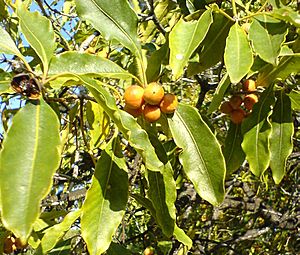Pittosporum undulatum facts for kids
Quick facts for kids Pittosporum undulatum |
|
|---|---|
 |
|
| Scientific classification | |
| Genus: |
Pittosporum
|
| Species: |
undulatum
|
Pittosporum undulatum is a tree that can grow up to 15 meters (about 50 feet) tall. It has leaves with wavy edges. After it flowers in spring or early summer, it grows bright orange, woody fruits. These fruits are about 1 centimeter (less than half an inch) wide and stay on the tree for several months.
This tree is also known by other names like sweet pittosporum, native daphne, Australian cheesewood, Victorian box, or mock orange.
Pittosporum undulatum grows very quickly. Because of this, it has become an invasive plant in some parts of Australia where it doesn't naturally belong. It is also a big problem in places like South Africa, the Caribbean, Hawaii, the Azores, and southern Brazil.
Contents
What it Looks Like
Pittosporum undulatum can grow as a large bush or a small tree. It reaches heights of up to 15 meters (50 feet).
Where it Lives
Originally, Pittosporum undulatum grew in wet areas along the east coast of Australia. Its natural home stretched from southeastern Queensland down to eastern Victoria. However, it has spread to many new areas since Europeans arrived in Australia.
How it Grows and Spreads
The flowers of Pittosporum undulatum smell very sweet at night. This scent likely attracts moths and butterflies, which help pollinate the flowers. Birds like currawongs, red-whiskered bulbuls, and Indian mynahs eat the fruits. Grey-headed flying foxes also enjoy them. When these animals eat the fruits, they spread the seeds in their droppings.
Why it Can Be a Problem
The first time P. undulatum was officially recorded in the Sydney area was in 1803. Even though it is native to the Sydney region, it has spread into new types of soil and bushland where it wasn't found before European settlement. It often grows faster and takes over from other native plants.
Pittosporum undulatum does especially well in places where humans have changed the environment. For example, when natural areas are broken up into smaller pieces, it can weaken other native plants. Also, fertilizer runoff from homes can make the soil richer, which P. undulatum likes. The stopping of bushfires near towns also helps it spread. Unlike most native plants, P. undulatum thrives in rich soil, and its seeds don't need fire to sprout.
Because of these reasons, some people call this species "invasive." However, some others think it is just returning to areas where it grew before people arrived in Australia and started burning the land much more often.
To control its spread, experts suggest finding and removing female trees. This helps stop new seeds from being made. Carefully planned burning can also help, along with removing weeds afterward.
Images for kids
-
P. undulatum in the Oxley Wild Rivers National Park
See also
 In Spanish: Pittosporum undulatum para niños
In Spanish: Pittosporum undulatum para niños






